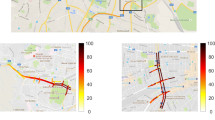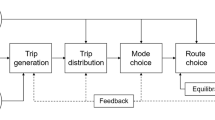Abstract
With the direct linkage to a travel map system, geostatistical techniques have been recently adopted for urban travel time estimation. Some important traffic characteristics of urban transportation networks, however, have not been adequately addressed in these studies. As an improvement over the existing studies, this study incorporates the directional effect of traffic into several commonly used geostatistical models for travel time estimation. We show that model performance can be significantly enhanced when flow specific properties are explicitly considered in constructing the associated interpolation models. The developed methodology is applied to a set of traffic data collected in the city of Tucson, Arizona during the rush hours. Results demonstrate an average of 20 % reduction in RMSE compared with those by the traditional approaches.










Similar content being viewed by others
References
Shen, L.: Freeway Travel Time Estimation and Prediction Using Dynamic Neural Networks. Florida International University, Dissertation (2008)
Leonard II, J.D., Simas de Oliveiria, M.G.: Geoinformatics clears traffic jams—travel-time contours visualize traffic weather. GeoInformatics. 22–25 (2001)
Du, J., Aultman-Hall, L.: Using spatial analysis to estimate link travel times on local roads. Transportation Research Board 2006 Annual Meeting CD-ROM, paper 06–0676 (2006)
Miura, H.: A study of travel time prediction using universal kriging. TOP 18(1), 257–270 (2010)
Belomestny, D., Jentsch, V., Schreckenberg, M.: Completion and continuation of nonlinear traffic time series: a probabilistic approach. J. Phys. A Math. Gen. 36, 11369–11383 (2003)
Liu, Y., Goodchild, M.F., Guo, Q., Tian, Y., Wu, L.: Towards a general field model and its order in GIS. Int. J. Geogr. Inf. Sci. 22(6), 623–643 (2008)
Matheron, G.: Principles of geostatistics. Econ. Geol. 58, 1246–1266 (1963)
Journel, A.G., Huijbregts, C.J.: Mining Geostatistics. Aademic Press, London (1978)
Isaaks, E.H., Srivastava, R.M.: An Introduction to Applied Geostatistics. Oxford University Press, New York (1989)
Cressie, N.: Statistics for Spatial Data. Revised Edition. Wiley, New York (1993)
Delhomme, J.P.: Kriging in the hydrosciences. Adv. Water Resour. 1, 251–266 (1978)
Volpi, G., Gambolati, G.: On the use of a main trend for the kriging technique in hydrology. Adv. Water Resour. 1, 345–349 (1978)
Kitanidis, P.K.: Introduction to Geostatistics: Applications in Hydrogeology. Cambridge University Press, Cambridge, U.K. (1997)
Abtew, W., Obeysekera, J., Shih, G.: Spatial analysis for monthly rainfall in south Florida. Water Resour. Bull. 29(2), 179–188 (1993)
Holawe, F., Dutter, R.: Geostatistical study of precipitation series in Australia: time and space. J. Hydrol. 219, 70–82 (1999)
Lajaunie, C.: Local risk estimation for a rare noncontagious disease based on observed frequencies. Note N-36/91/G. Centre de Geostatistique, Fontainebleau, Ecole des Mines de Paris (1991)
Webster, R., Oliver, M.A., Muir, K.R., Mann, J.R.: Kriging the local risk of a rare disease from a register of diagnoses. Geogr. Anal. 26, 168–185 (1994)
Goovaerts, P.: Geostatistical analysis of disease data: estimation of cancer mortality risk from empirical frequencies using Poisson kriging. Int. J. Heal. Geogr. 4, 31 (2005)
Chica-Olmo, J.: Spatial estimation of housing prices and locational rents. Urban Stud. 32(8), 1331–1344 (1995)
Montero-Lorenzo, J.-M., Larraz-Iribas, B.: Estimating commercial property prices: an application of cokriging with housing prices as ancillary information. J. Geogr. Syst. 11, 407–425 (2009)
Huijbregts, C.J., Matheron, G.: Universal kriging (An optimal method for estimating and contouring in trend surface analysis). In proceedings of Ninth International Symposium on Techniques for Decision-Making in the Mineral Industry. In: McGerrigle, J.I. (eds.) The Canadian Institute of Mining and Metallurgy, Special Volume 12, pp. 159–169 (1971)
Myers, D.E.: Matrix formulation of co-kriging. Math. Geol. 14(3), 249–257 (1982)
Stein, A., Corsten, L.C.A.: Universal kriging and cokriging as a regression procedure. Biometrics 47, 575–587 (1991)
Dia, H.: An object-oriented neural network approach to short-term traffic forecasting. Eur. J. Oper. Res. 131(2), 253–261 (2001)
Rice, J., van Zwet, E.: A simple and effective method for predicting travel times on freeways. IEEE Trans. Intell. Transp. Syst. 5(3), 200–207 (2004)
Ciuffo, B.F., Punzo, V., Quaglietta, E.: Kriging meta-modelling to verify traffic micro-simulation calibration methods. Transportation Research Board 2011 Annual Meeting CD-ROM, paper 11–0451
Selby, B., Kockelman, K.: Spatial prediction of AADT in unmeasured locations by universal kriging. Transportation Research Board 2011 Annual Meeting CD-ROM, paper 11–1665
Bureau of Public Roads: Traffic Assignment Manual. U.S. Dept. of Commerce, Urban Planning Division, Washington D.C (1964)
Author information
Authors and Affiliations
Corresponding author
Rights and permissions
About this article
Cite this article
Tong, D., Lin, WH. & Stein, A. Integrating the Directional Effect of Traffic into Geostatistical Approaches for Travel Time Estimation. Int. J. ITS Res. 11, 101–112 (2013). https://doi.org/10.1007/s13177-013-0061-0
Received:
Revised:
Accepted:
Published:
Issue Date:
DOI: https://doi.org/10.1007/s13177-013-0061-0




